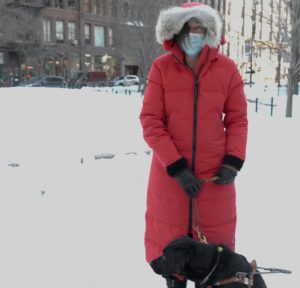Caregivers Deserve Better
by Beth Finke
 Our son Gus was born in 1986 with significant physical and developmental disabilities. He lived at home with us until he was 16 years old. After that, he was cared for at a group home in Watertown, Wisconsin.
Our son Gus was born in 1986 with significant physical and developmental disabilities. He lived at home with us until he was 16 years old. After that, he was cared for at a group home in Watertown, Wisconsin.
Until December of last year, that is. That’s when my husband Mike and I were notified by the organization who ran Gus’ group home that they would be permanently closing their residential operations, at least partly due to the financial burdens COVID had caused.
We thought Gus would be living under their care for the rest of his — and our — lives. The news that the home would be ending its housing services proved to be an anxious daily worry for months to come.
COVID vaccines were not readily available yet in December 2020. COVID protocol did not allow us to visit Gus in-person then, and Mike and I were already pretty stressed out by living through a year of pandemic-related unknowns. Adding this new unknown — where would Gus live now — nearly toppled us.
A case worker was assigned to find a new placement for Gus, and COVID protocols meant we would not be allowed to visit any of the facilities the case worker found. Not in-person, at least. Our only option was to visit them virtually, and Zoom was the only way to meet and talk with the people who might be caring for our son from here on.
When the case worker found another group home with an opening, I was all for it. It was closer to us than the other one, and I feared we wouldn’t find anything better. But Mike wanted to hold out. He hoped against hope that Gus’ original home would find an organization to take over the house he was familiar with — the one he’d lived in for so long. That would be ideal, Mike said. Gus wouldn’t have to move, and current staff could even be retained.
But why would any organization take over the house Gus lived in during COVID times? Even before the pandemic hit, low pay and hard work had already been motivating staff members to leave for higher-paying jobs. One constant throughout all our son’s years in a community setting: direct-care providers caring for him have always, always been underpaid. Over the years we learned to expect high staff turnover.
Low pay causes instability in the lives of the workers and the lives of the people they care for, and the necessity for social distancing and mask-wearing made this past year even more difficult on the workers and the individuals and families who rely on them.
So I was pleased to hear President Biden had proposed something in his infrastructure plan to help the caregiving community: his original proposal included $400 billion in federal spending for Medicaid’s home and community-based services program, a program our son Gus participates in.
That all changed, unfortunately, when the president and a group of bipartisan senators recently reached a compromise to drop this aid.
But back to Gus. Mike argued that if we held out, didn’t place Gus in a new home, and another organization did take over operations of the house Gus was at, Gus would be likely to keep the same caseworkers, staff, and doctors who already know him. Mike had a good point there. Finding doctors and dentists who are willing to treat people like Gus is not always easy.
And then it happened. On April 28, 2021, we received an email from Gus’ original home announcing that they had agreed to sell to another organization.
Mike almost broke down crying while reading the email out loud to me. “I must have been walking around worrying about it all the time,” he said later. “I guess it was weighing on me more than I thought.”
COVID restrictions were loosening up then, and after a year apart, we could finally come visit Gus again, this time with his house under new ownership.
Typically, we call the house on the drive up to let them know we’re coming — and to be sure they’d be there and didn’t have some outing planned. The day we visited, the house phone was busy. And busy. And busy. Without being able to get through on the phone, we showed up unannounced.
Gus’ house is actually a duplex, with 8 residents, four bedrooms, a living room and a kitchen on each side. That way staff members can toggle between as necessary.
When we arrived that day and rang the bell on Gus’ side, there was no answer. I worried they were out on an outing. Maybe we’d missed him.
Mike went to the other side then, and a staff member opened the door. All the residents were just finishing lunch. Two staff members were usually at each side of the duplex, but this time only one staff member was there to take care of both sides. When Mike explained that we’d tried to call, she apologized and said she’d just realized the phone was knocked off the hook. And the doorbell we’d been ringing? It was broken.
Mike and I went to Gus’ room and found him lounging on his couch, well groomed, and happy to see us. We never found out why only one staff member was there, but we could make an educated guess.
Funding home-and community-based care for the most vulnerable Americans shouldn’t be a partisan issue. Lawmakers need to do everything they can to work this aid back into the federal budget. Caregivers and the people they care for deserve it.















